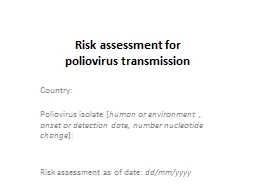

Country Poliovirus isolate human or environment onset or detection date number nucleotide change Risk assessment as of date dd mm yyyy Part 1 Risk analysis by WHO WHOHQ analysis conducted within 2448 hours of incident report To be adapted and supplemented by Regional Offi ID: 928806
Download Presentation The PPT/PDF document "Risk assessment for poliovirus transmis..." is the property of its rightful owner. Permission is granted to download and print the materials on this web site for personal, non-commercial use only, and to display it on your personal computer provided you do not modify the materials and that you retain all copyright notices contained in the materials. By downloading content from our website, you accept the terms of this agreement.
Slide1
Risk assessment for poliovirus transmission
Country:
Poliovirus isolate [
human or environment , onset or detection date, number nucleotide change
]:
Risk assessment as of date:
dd
/mm/
yyyy
Slide2Part 1: Risk analysis by WHO*
*WHO/HQ analysis conducted within 24-48 hours of incident report. To be adapted and supplemented by Regional Office and Country Office Risk Assessments and Analyses
Slide3Epidemiologic details
Case/sample details
Type of virus: [
wild / VDPV/ Sabin2
]
Virus serotype: [type 1, 2, 3]Source: [AFP / Environment/ asymptomatic person]EPID no:Date of onset or date ES collected:Reporting to CO/RO:Reporting date to WHO HQ:Location of onset of the case / envir. sample collection site:[if a person] Age and OPV dose status: Sequencing results: Nature of virus [nt difference from Sabin and closest matching sequence if available/applicable] + evidence of circulationBrief overview of most recent VDPV / WPV and responseCase / envir. sample details Virus type [wild / VDPV; serotype]Date of onset / Date of ES collectedLocation# of SIA since most recent case / positives envir. IsolateType of vaccine used in response (mOPV2, nOPOV2, tOPV)
3
Slide4Map location of [the case or
envir
. sample collection site
]
4
Slide5Immunization performance
Polio vaccination (OPV/IPV) status of NP AFP cases 6-59 months
[bar graphs]
Nationwide
Infected Admin 1 (or Admin 2, if applicable)
% of Zero dose% of 3+ doses Conclusions/inferences: SIANumber of SIAs conducted current year, incl. (LQAS/IM) results + type of vaccine used [indicate whether infected area was covered] see notesDetails of SIAs conducted previous year, incl. (LQAS/IM) results + type of vaccine used [indicate whether infected area was covered] see notes Conclusions/inferences: Routine immunization (source: WHO/UNICEF best estimates)Pol3 (OPV/IPV) and DTP3, current yearPol3 (OPV/IPV) and DTP3, previous year(s) Conclusions/inferences: Date of tOPV-bOPV switch: [dd-mm-YYYY]Time after cessation of OPV2
[
weeks/months/years elapsed between OPV2 cessation and detection of PV]
Date of IPV introduction
: [
dd-mm-YYYY]Extent: [nationwide? If not, where?]
5
Slide6AFP surveillance performance
Epidemiologic curves
(previous 3 years) [
bar graph, by week of onset
]National levelInfected Admin 1 levelNP AFP rate and Stool adequacy (if possible, mapping at Admin 1 level)Calendar year / Previous 12 monthsPrevious 6 monthsEnvironmental surveillance (if applicable)Monthly environmental chart for at least last 12 months by collection site and by province Conclusions / inferences:6
Slide7Country context
Population
Population <15 and <5 in infected Admin 1 and Admin 2
In-country population movement
(within country – focusing on infected area)
Internal movement of people, focus on infected areaIDPsHigh risk population (in infected areas, especially) [if applicable]Characteristics (e.g., refugee, IDPs, inaccessible communities)Reasons for considering it has “high risk”International borders, neighbouring country(s) and population movement [if applicable]Proximity of affected area to bordersTrade and travel patternsRefugee movementSecurity [Natural disaster, political instability, criminality/terrorism] (if applicable)Upcoming major events in country that may affect response (e.g. elections, meetings that may involved key MOH staff) [if applicable]
7
Slide8Country capacity
National immunization service delivery
( as expressed by national EPI manager or higher authority)
Immunization service system: [
strong / moderate / weak (specify)
]Human resources for management at all level: [adequate /inadequate /acute shortage, (specify)]Human resources for service delivery: [adequate /inadequate/acute shortage (specify)]Country’s past experience in conducting polio SIA:Country’s past experience in conducting other immunization campaign:GPEI-funded Human Resources in country [if applicable, use a table]Number, location/level of duty, Functions: Continued availability: till mm/yyyy8
Slide9Detailed polio case investigation [To be completed by Regional Office and Country Office once information is available]
Key findings of field investigation
[
if known / if applicable
]
Missed AFP cases found through active case search in the community and health facilities:OPV/IPV coverage status assessed through rapid community survey:Number and lab testing results of samples taken from contacts (AFP) / community (ES):Health seeking behaviour of AFP case / missed opportunity to have reported the case earlier (if applicable):Travel links & population movement:Travel to other areas in-country: names of the districtsTravel to other country: name of country and district, province9
Slide10Sub regional/regional risk (if applicable)
10
Slide11Proposed course of action (1)[To be completed by Regional Office and Country Office once information is available]
1. Field investigation
Laboratory investigation:
Further case investigation & case finding :
2. Enhance ongoing surveillance measures
(AFP, environmental):3. Enhance /catch-up routine immunization (including bOPV and IPV):11
Slide12Proposed course of action (2)[To be completed by Regional Office and Country Office once information is available]
4. Plans for vaccine response :
OPV2
requested:
[YES/NO]
at this time Rationale (briefly)Target population, geographic area, age groupDoses requested for each roundProposed dates SIA 1/2/3Type of OPV requested (mOPV2, nOPV2, tOPV) and justification of the choice 5. Plans to inform neighbouring countries : [who, when, how, by whom]12
Slide13Map of proposed area for OPV2
(and IPV use [if applicable])
13
Slide14Part 2: Discussion on vaccine provision**
Please note: country / regional offices complete ONLY Part 1
Slide15discussion, conclusion and recommendations
Assess risk
Virological
risk
Contextual risk of further
transmissionRisk for international spreadAssess need for OPV2 and evaluate vaccine request [if applicable]Type of vaccine (mOPV2, nOPV2, tOPV) number of doses/rounds/extent/ageIPV [if applicable]Provide recommendation to WHO DG [if applicable]Provide recommendations to countryInstructions to UNICEF SD15Box instructions: Risk Potential:
“
Low
/
Medium
/ High”